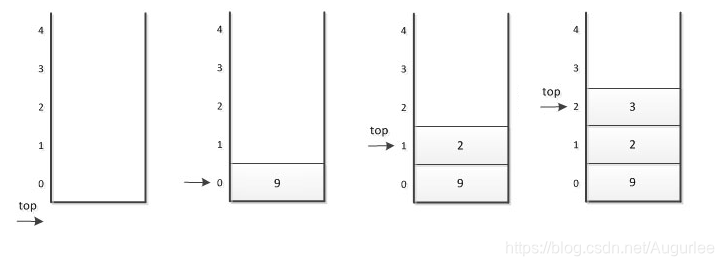顺序栈

- 预先分配一块连续的内存用于存放栈中的元素,并设栈顶指针
top指示栈顶元素; - 初始值
top = -1 - 入栈/出栈后,
top++/top-- - 当
top == -1时,为空栈; - 当
top == MAX_SIZE-1时,栈溢出,需要内存扩容
栈声明:
template <class T>
class MyStack
{
public:
MyStack(int capacity = DEFAULT_CAPACITY); // 构造函数
MyStack(const MyStack<T>& other); // 复制构造函数
~MyStack(); // 析构函数
MyStack<T>& operator=(const MyStack<T>& other); // 赋值运算
T& top() const; // 返回栈顶元素
bool empty() const; // const修饰表明只读取数据成员
int size() const; // 返回元素个数
void push(const T& item); // 压栈
void pop(); // 出栈
void emplace(const T& item); // 玄学压栈,不作实现
void swap(MyStack& other); // 交换
private:
T* stack; // 栈容器
int capacity; // 当前容量
int topIndex; // 栈顶索引
void expand(); // 容量扩充
};
栈实现:
template<class T>
inline MyStack<T>::MyStack(int _capacity) : capacity(_capacity)
{
if (capacity <= 0) throw "stack capacity must be >0";
stack = new T[capacity];
topIndex = -1;
}
template<class T>
inline MyStack<T>::MyStack(const MyStack<T>& other)
{
*this = other;
}
template<class T>
inline MyStack<T>::~MyStack()
{
delete[] stack;
stack = nullptr;
}
template<class T>
inline MyStack<T>& MyStack<T>::operator=(const MyStack<T>& other)
{
delete[] stack;
topIndex = other.topIndex;
capacity = other.size();
stack = new T[capacity];
std::copy(other.stack, other.stack + other.size(), stack);
return *this;
}
template<class T>
inline bool MyStack<T>::empty() const
{
return -1 == topIndex;
}
template<class T>
inline int MyStack<T>::size() const
{
return topIndex + 1;
}
template<class T>
inline T& MyStack<T>::top() const
{
if (empty()) throw "ERROR: Stack is empty";
return stack[topIndex];
}
template<class T>
inline void MyStack<T>::push(const T& item)
{
if (topIndex == capacity - 1)
expand();
stack[++topIndex] = item;
}
template<class T>
inline void MyStack<T>::pop()
{
if (empty()) throw "Stack is empty. Delete failed.";
stack[topIndex--].~T(); // 指针递减,成员析构
}
template<class T>
inline void MyStack<T>::emplace(const T& item)
{
push(item);
}
template<class T>
inline void MyStack<T>::swap(MyStack& other)
{
MyStack<T> temp(other);
other = *this;
*this = temp;
}
template<class T>
inline void MyStack<T>::expand()
{
capacity *= 2;
T* temp = new T[capacity];
std::copy(stack, stack + this->size(), temp);
delete[] stack;
stack = temp;
}
顺序队列

- 预先分配一块连续的存储单元存放队列中的元素,并设队头指针
front指示队头元素、队尾指针rear指示队尾元素的下一个位置; - 初始值
front = rear = 0 - 入队/出队后,
rear++/front++ - 当
front == rear时,队列为空; - 当
rear==MAX_SIZE时,队列已满(假溢出),需要内存扩容,但此时可能存在内存闲置。
循环队列
循环队列是一种改进的顺序队列结构,操作表现同样基于 FIFO(先进先出)原则,但队尾被连接在队首之后形成一个循环,也被称为“环形缓冲器”。
优点是能够允许利用之前释放的空间,解决“假溢出”问题。

- 为了更好地判断循环队列的队空和队满边界,需要牺牲 最后一个 存储单元
- 预先分配一块连续的存储单元存放队列中的元素,并设队头指针
front指示队头元素、队尾指针rear指示队尾元素的下一个位置; - 初始值
front = rear = 0 - 入队包括回绕入队
rear = (rear+1) % MAX_SIZE - 出队包括回绕出队
front = (front+1) % MAX_SIZE - 当
front == rear时,队列为空; - 当
(rear+1) % MAX_SIZE == front时,队列溢出,需要内存扩容
/*********************************************************
* Data Structures in C++
* @file MyQueue.h
* @author QCH
* @date 2020/03/19
* @brief 顺序队列的实现,注意回绕的处理方式,空出队头位置
* Copyright (c) 2016-2020. All rights reserved.
*********************************************************/
#pragma once
#define DEFAULT_CAPACITY 10
template<class T>
class MyQueue
{
public:
MyQueue(int _capacity = DEFAULT_CAPACITY);
MyQueue(const MyQueue<T>& other);
~MyQueue();
MyQueue<T>& operator=(const MyQueue<T>& other);
T& front();
T& back();
bool empty();
int size();
void push(const T& item);
void pop();
void emplace(const T& item);
void swap(const MyQueue<T>& other);
private:
T* queue; // 队列容器
int counter; // 计数
int capacity; // 容量
int frontIndex; // 前项索引
int backIndex; // 后项索引
void expand(); // 容量扩充
};
/*********************************************************************
* 由于编译器只能通过include“看到”头文件而找不到模板实现代码
* 为避免产生链接问题, 模板类的声明和定义必须放在一起
*********************************************************************/
template<class T>
inline MyQueue<T>::MyQueue(int _capacity) : capacity(_capacity)
{
if (capacity <= 0) throw "Capacity must be >0";
queue = new T[capacity];
frontIndex = backIndex = counter = 0;
}
template<class T>
inline MyQueue<T>::MyQueue(const MyQueue<T>& other)
{
*this = other;
}
template<class T>
inline MyQueue<T>::~MyQueue()
{
delete[] queue;
queue = nullptr;
}
template<class T>
inline MyQueue<T>& MyQueue<T>::operator=(const MyQueue<T>& other)
{
delete[] queue;
capacity = other.capacity;
queue = new T[capacity];
std::copy(other.queue, other.queue + capacity, queue);
frontIndex = other.frontIndex;
backIndex = other.backIndex;
counter = other.counter;
return *this;
}
template<class T>
inline T& MyQueue<T>::front()
{
if (empty()) throw "ERROR: Queue is empty!";
return queue[(frontIndex + 1) % capacity];
}
template<class T>
inline T& MyQueue<T>::back()
{
if (empty()) throw "ERROR: Queue is empty!";
return queue[backIndex];
}
template<class T>
inline bool MyQueue<T>::empty()
{
return frontIndex == backIndex;
}
template<class T>
inline int MyQueue<T>::size()
{
return counter;
}
template<class T>
inline void MyQueue<T>::push(const T& item)
{
if ((backIndex + 1) % capacity == frontIndex) // 队列满了
{
expand();
frontIndex = 0;
backIndex = capacity - 1;
capacity *= 2;
}
//if (backIndex == capacity - 1)
// backIndex = 0;
//else
// backIndex++;
backIndex = (backIndex + 1) % capacity; // 回绕的高水平写法
queue[backIndex] = item;
counter++;
}
template<class T>
inline void MyQueue<T>::pop()
{
if (empty()) throw "ERROR: Queue is empty!";
frontIndex = (frontIndex + 1) % capacity; // 回绕的高水平写法
queue[frontIndex].~T();
counter--;
}
template<class T>
inline void MyQueue<T>::emplace(const T& item)
{
push(item);
}
template<class T>
inline void MyQueue<T>::swap(const MyQueue<T>& other)
{
MyQueue<T> temp(other);
other = *this;
*this = temp;
}
template<class T>
inline void MyQueue<T>::expand()
{
T* temp = new T[capacity * 2];
if (frontIndex < backIndex)
std::copy(queue, queue + capacity, temp);
else
{
std::copy(queue + frontIndex, queue + capacity, temp);
std::copy(queue, queue + frontIndex, temp + capacity - frontIndex);
}
delete[] queue;
queue = temp;
}